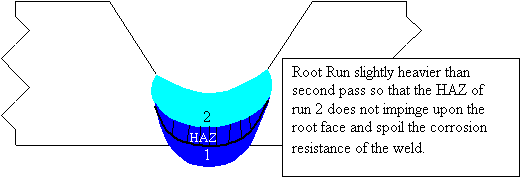Typically twice the yield of austenitic stainless steels. Minimum Specified UTS typically 680 to 750N/mm2 (98.6 to 108ksi). Elongation typically > 25%. Superior corrosion resistance than a 316. Good Resistance to stress corrosion cracking in a chloride environment. Duplex materials have improved over the last decade; further additions of Nitrogen have been made improving weldability. Because of the complex nature of this material it is important that it is sourced from good quality steel mills and is properly solution annealed. Castings and possibly thick sections may not cool fast when annealed causing sigma and other deleterious phases to form. The material work hardens if cold formed; even the strain produced from welding can work harden the material particularly in multi pass welding. Therefore a full solution anneal is advantageous, particularly if low service temperatures are foreseen. The high strength of this material can make joint fit up difficult. Usable temperature range restricted to, -50 to 280°C Used in Oil & Natural Gas production, chemical plants etc. Standard Duplex
Super Duplex: Stronger and more corrosion
resistant than standard duplex.
Duplex solidifies initially as ferrite, then transforms on further cooling
to a matrix of ferrite and austenite. In modern raw material the
balance should be 50/50 for optimum corrosion resistance, particularly
resistance to stress corrosion cracking. However the materials strength
is not significantly effected by the ferrite / austenite phase balance.
The main problem with Duplex is that it very easily forms brittle intermetalic
phases, such as Sigma, Chi and Alpha Prime. These phases can form
rapidly, typically 100 seconds at 900°C. However shorter exposure
has been known to cause a drop in toughness, this has been attribute to
the formation of sigma on a microscopic scale.
Sigma (55Fe 45Cr) can be a major problem when welding thin walled small bore pipe made of super duplex, although it can occur in thicker sections. It tends to be found in the bulk of the material rather than at the surface, therefore it probably has more effect on toughness than corrosion resistance. Sigma can also occur in thick sections, such as castings that have not been properly solution annealed (Not cooled fast enough). However most standards accept that deleterious phases, such as sigma, chi and laves, may be tolerated if the strength and corrosion resistance are satisfactory. Nitrogen is a strong austenite former and largely responsible for the balance between ferrite and austenite phases and the materials superior corrosion resistance. Nitrogen can’t be added to filler metal, as it does not transfer across the arc. It can also be lost from molten parent metal during welding. Its loss can lead to high ferrite and reduced corrosion resistance. Nitrogen can be added to the shielding gas and backing gas, Up to about 10%; however this makes welding difficult as it can cause porosity and contamination of the Tungsten electrode unless the correct welding technique is used. Too much Nitrogen will form a layer of Austenite on the weld surface. In my experience most duplex and super duplex are TIG welded using pure argon. Backing / purge gas should contain less than 25ppm Oxygen for optimum corrosion resistance. Fast cooling from molten will promote the formation of ferrite, slow cooling will promote austenite. During welding fast cooling is most likely, therefore welding consumables usually contain up to 2 - 4% extra Nickel to promote austenite formation in the weld. Duplex should never be welded without filler metal, as this will promote excessive ferrite, unless the welded component is solution annealed. Acceptable phase balance is usually 30 – 70% Ferrite Duplex welding consumables are suitable for joining duplex to austenitic stainless steel or carbon steel; they can also be used for corrosion resistant overlays. Nickel based welding consumables can be used but the weld strength will not be as good as the parent metal, particularly on super duplex.
Tight controls and the use of arc monitors are recommended during welding and automatic or mechanised welding is preferred. Repair welding can seriously affect corrosion resistance and toughness; therefore any repairs should follow specially developed procedures. See BS4515 Part 2 for details. Production control test plates are recommended for all critical poduction welds. Welding procedures should be supplemented by additional tests, depending on the application and the requirements of any application code:-
Typical Welding Procedure For Zeron 100 (Super Duplex) Pipe 60mm Od x 4mm Thick Position 6G Maximum Interpass 100°C Temperature at the end of welding < 250°C 1.6mm Filler Wire 85 amps 2 weld runs (Root and Cap) Arc energy 1 to 1,5 KJ/mm Travel speed 0.75 to 1 mm/sec
Recommended Testing
Return To Sub Menu Last Modified 19 March 2002 |



